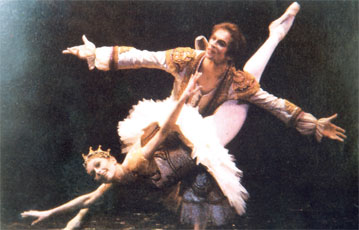The Russian Imperial Ballet moves in
by Gwen Herat
After the Romantic movement, especially in Italy, many choreographers
were eager to move on and not rest upon the aegis of Romanticism and it
was under this atmosphere that the Russian Imperial ballet moved in.
This was the time that dancers and choreographers were entering one of
the most important era of change.
 |
|
From barre to pointe work... the
strenuous and disciplined training emerging from the
Imperial Ballet Theatre, are the results we see today. |
To appreciate ballet in Russia one has to turn the clock on France's
Romanticism back to about a hundred years or over. In the 17th century
dancers and their kind were a common sight in the courts of the Tsars
and the rich and influential. Unlike in Italy and France, the male
dancer dominated because the dancers were closer to the land and held
such exuberance and vigour. The female dancers had to take the second
place.
Even today the male dancer is the important of the two; not until one
of their great sons in the 20th century changed course for them. It was
Rudolf Nureyev who was to blaze the trail as the finest of the century,
after defecting to the West in 1962. He placed the male dancer centre
stage and pushed the ballerina to where she should be. Russia was not
happy about it.
From 1672 to 1725 Russia was stirring towards a cultural movement
which the then Peter the Great was determined to achieve but he had the
obstacles because he was bent more on military supremacy and toured
Europe in search of it. It was then that he realised that alone was not
enough but Russia also should be able to lift herself culturally. In
this process he was enamoured by Western ballet and its grace and the
music that went with it. He realised the difference in the crude folk
dancing though energetic as against the graceful movements of ballet.
Passionate
Peter was so possessive and passionate about this art that he brought
many such dancers from European countries to begin his dream. And in
1734 a French dancer, Jean-Baptist Lande who was also a ballet master,
arrived in St. Petersburg. He took up the post of ballet master in an
orphanage for poor children. At this time ballet was thriving in the
West especially in Paris and Dresden. Lande continued to inspire ballet
so much that he caught the eye of Empress Anne. So, one year after his
arrival in St. Petersburg the Empress called on him to form the Academy
of Dancing which led to the establishment of the Imperial Theatre School
at the Winter Palace. It has 12 boys and 12 girls. Lane became the first
director and he worked tirelessly that resulted in the birth of the
Russian Imperial Ballet.
Russia received a further stimulus when Catherine the Great ascended
the throne. She invited the controversial Italian dancer / choreographer
/ composer, Gasparo Angiolini to succeed Hilherding van Wewen claiming
that the latter's practice of revealing the stories behind ballets is
not necessary. Any ballet should be self-explanatory by movements alone
and it has been proved right to this day around the world wherever
ballet is performed.
With the arrival with yet another dancer, Charles Le Picq who took up
the position of ballet master at St. Petersburg along with his wife
Gertrude who went on to become the 'prima ballerina' of the company. La
Picq who was Noverre's star pupil, introduced many of Noverre's ballets
ensuring that without fail Russia maintained the traditions of the
French ballet.
Orphanage
All this was a great jump from Lande's poor orphanage training to
what was to come that made Russian so supreme in her ballet, second only
to English ballet. At St. Petersburg the news of a iconic French dancer
and choreographer, Charles Louis Didelot was exploding and mesmerising
his audiences after doing the same in London and Paris reached the ears
of Paul 1, Emperor of Russia who immediately asked him to take over St.
Petersburg which he did from 1801 to 1811. He was the star who created
13 ballets with some of the graduates from the Imperial Theatre School.
 |
|
Rudolf Nureyev and Patricia Nuanne is
the perfect combination for the ‘fish-dive.’ Nureyev was the
greatest dancer that Russia's ever produced and went on to
make the world his stage. |
However, Didelot found an ever-growing difficult period because the
directors who came under his wings were not well disposed towards him as
head of the Imperial Ballet Theatre. It was the scheming underhand
malice of Prince Gagarin that frustrated him to quit before he was
dismissed all due to mounting jealousy of ballet's enormous powers he
held. Dejected and heartbroken without it because ballet had been his
life, Didelot died in 1836 in Kiev.
Stimulus
At a time when it was low and to provide a useful stimulus, Marie
Taglioni arrived in St. Petersburg to dance La Sylphide and other works.
She was followed by yet another icon called Marius Petipa. He came from
a theatrical background whence his father had been a ballet master and
his mother a premier dancer. He uplifted the standard of Russian ballet
and in 1845 became the Professor of Dancing at the Imperial Theatre
School. Thus was the beginning of the momentum in Russian ballet whose
perfect excellence we see in their dancer and who maintain the great
traditions set before them to go into the future with the same aplomb.
Russian ballet has her own syllabus whereas the rest of the world follow
the one set by the Royal Ballet.
Russian ballet is foremost not only in mounting the glassics but many
of Shakespeare plays. It played a great role in promoting their great
composers, some who especially scored for ballet.
|


